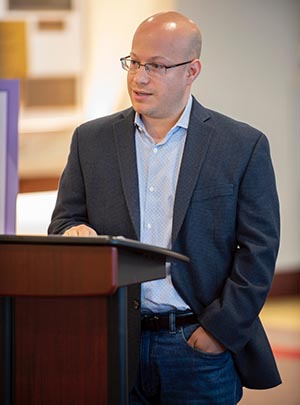Hsu, Rivnay collaboration receives inaugural Catalyst Award
When Northwestern Medicine and the McCormick School of Engineering began seeking applications for the inaugural Collaborative Research Catalyst Awards, Erin Hsu and Jonathan Rivnay recognized the opportunity. The new program was a perfect fit for the Simpson Querrey Institute (SQI).
The Catalyst Awards require one principal investigator to be an employed physician with Northwestern Medicine and another to be a McCormick faculty member. SQI supports investigators fitting each of those descriptions in its efforts to promote research convergence in basic science, engineering and medicine.

Rivnay, assistant professor of biomedical engineering, will team with Wellington Hsu, a spine surgeon, and Erin Hsu, a bone biologist, both in the department of Orthopaedic Surgery in the Feinberg School of Medicine, to study a novel technique for bone regeneration and spine fusion. On June 25, the three SQI faculty members were one of two teams — out of 30 that were considered — to accept a Catalyst Award for $55,000.
“This collaboration kind of embodies that systematic approach that we’re going for at SQI,” said Erin Hsu, the assistant director of SQI. “You want to put the biologist and the materials scientist and the clinician together.”
Current approaches to spine fusion surgery involve harvesting and repurposing bone from the patient or delivering recombinant growth factors, but both have limitations. Growth factors are associated with serious side effects, while patient-derived bone grafts can lead to complications at the donor site or surgical non-union — which requires a second costly, invasive intervention.
Rivnay and the Hsus are seeking to avoid harvesting patients’ bones or delivering recombinant growth factors by modifying existing clinical materials. Using Rivnay’s expertise in conducting polymers, cadaveric bone that has been demineralized to expose the extracellular matrix of human bone will be processed to render the material electrically conductive. Rivnay’s group will develop and characterize the electrically active scaffolds, with a goal to direct host stem cells to differentiate into bone cells.
The Hsu Laboratory will perform the 3D stem cell culture studies on Rivnay’s composite materials, and the most promising iterations will be evaluated in a rat model of spine fusion. The researchers hope to demonstrate biocompatibility and robust bone regenerative capacity in order to generate sufficient pilot data to obtain large-scale extramural funding.
Although this particular project is focused on bone formation, Rivnay can envision using similar approaches for other medical applications including wound healing and nerve regeneration.
“The goal was to be able to covalently functionalize some of these materials that orthopedic surgeons would use for spinal fusion,” he said. “The hope is that it can be generalized. I think there’s a lot of promise for conducting polymers.”